After rye, I think spelt is my favourite flour to work and bake with. Even though it's closely related to wheat, spelt behaves remarkably different in baking. Whenever I bake mostly white spelt loaves, I opt for a 30 minute autolyse before mixing the final dough. After the autolyse, salt, levain and yeast (if using) are quickly incorporated in the dough. The mixing times tend to be extremely short - just a couple of minutes on first speed is often all that's required. I usually do two or sometimes three folds during bulk fermentation. As the dough ferments, it tends to "sweat", and it appears to release some of the water that was first mixed into it, so well floured hands, speed and a good dough scraper are essential.
Earlier today I baked one of my very favourite spelt loaves. This is a "pain de campagne"-style loaf, slightly rustic with 20% whole spelt, and a stiff spelt levain. I usually take 15% of the total flour from the ripe spelt sourdough. Many bakers have commented that spelt tends to bake to a very dry crumb. I've never really encountered that myself, but that's perhaps because I've stuck with roughly 67 - 68% hydration for these rustic loaves. And with my spelt flours, that translates to a significantly wetter dough than an equivalent 67% wheat-based dough. In this loaf, I also included lightly toasted pine nuts - these nuts lend a complex, pleasing flavour note to all-spelt loaves.
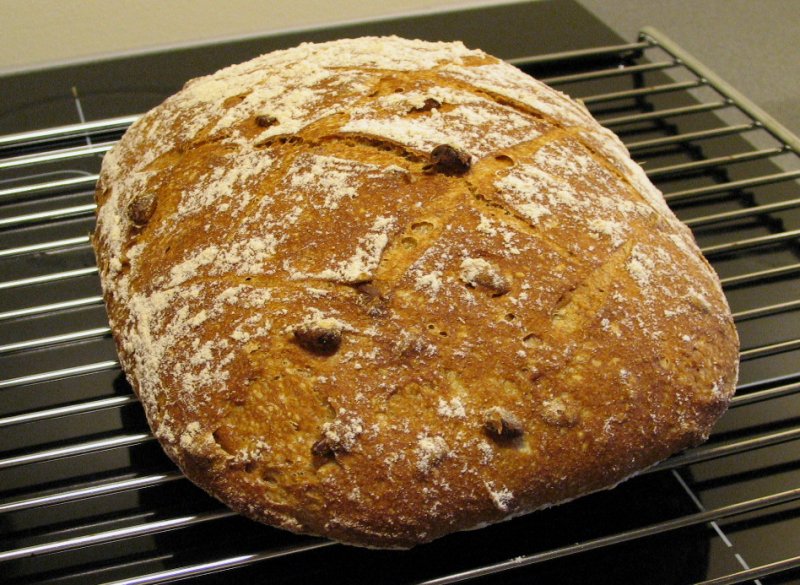
I've tried baking these in brotforms before, but I always end up having trouble getting the loaves out in one piece when it's time to put them in the oven. No matter how well I flour the brotforms, it seems that the shaped loaves "sweat" so much, that they're bound to get stuck to them. After several disappointments, I've settled on shaping them into rectangles on top of parchment that I put on the peel. Two to three folds during bulk and a moderately tight shape contribute some strength, and make them stand up pretty well, although I'm proofing them for over an hour.

Notice how brown the crumb is - and this is merely 20% whole flour. You can also see that the crust tends to be very thin, but definitely crackly and it packs a most wonderful flavour. Pair that with some toasted pine nuts, and this is a most rewarding loaf! Both spelt flour and pine nuts are costly items in my pantry, but I usually think the flavour of these loaves justify the extra $$$. If you're looking to try something new, definitely give spelt a try. It's not just hippie-loaves, y'know!
As some of you might know, I do have a particularly weak spot for rye. There is admittedly a steep learning curve when one is approaching high ratio ryes, but the rewards are great, and once familiar with how's and why's, it's a lovely (albeit sticky) grain to work with (in my opinion). I was thrilled when Nils, whose ye olde bread blogge is a source of constant inspiration and great knowledge, posted a link to a co-op (?) called Bäko Gruppe Nord in his latest entry. Several most interesting recipes are published at their site, and a couple of them I have bookmarked as "top priority". To start off, I've baked their Herbstzauber - a 60/40 dough that's mixed with rum-soaked dried fruit.
Thinking that a substantial blend-in of fruits would bog down a whole rye dough, I opted for medium rye flour in the 60/40 dough. Here's what I got right after mixing was over:
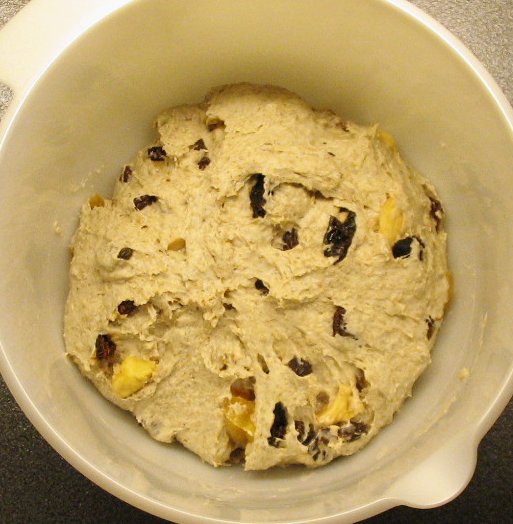
Once again, I went for a 1 kg boule, and here's the finished loaf:

I think the oven spring was surprisingly good, in spite of all the fruit and raisins in there. I rather generously doused the dried fruit in Cuban rum, so the booze that was not absorbed by the fruit went into the final dough. Terrific! Crumb:

I had also fixed my sight plainly on one of Bo Friberg's creations; this time a cake with the humble title of "raspberry cake". Simple as that! Well, it proved to take me the better part of a day to get it all together...
Starting from the bottom, the cake is made with a disc of baked short dough (I used some pâte sucrée leftover dough from the freezer) that's slathered with raspberry jam. Then, make a genoise base and split it in two - put one part directly on top of the raspberry jam, drench in syrup and place a healthy dose of fresh raspberries on top. Pour a (most heavenly tasting) gelatine-based raspberry cream over that, and put final genoise part on top. Once the cream is chilled and set, ice with Italian buttercream and decorate! Here's a shot from roughly half way through assembly: The raspberry cream is just poured over raspberries. Quickly slide on second genoise layer and put in fridge to set.
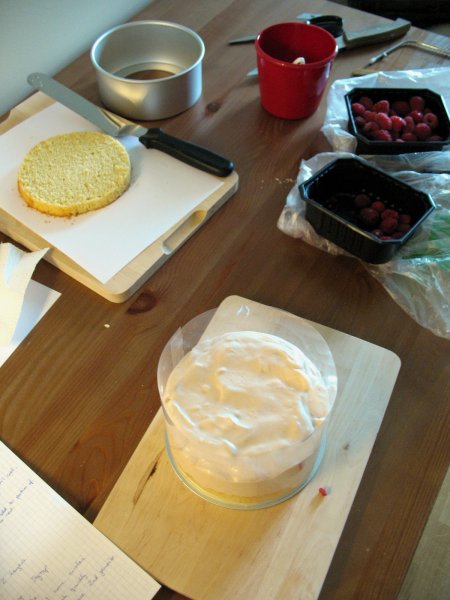
"... you know it balances on your head just like a mattress balances on a bottle of wine - your brand new leopard-skin pillbox hat..." Well, I'm doing the best I can ;) Below is the cake iced with the Italian buttercream. Not exactly pillbox-ed, but it'll have to do. (Need to work on corners, need to work on corners, need to work ...)

And here's how it came out in the end, with almonds pressed in on the sides, a layer of marzipan on top, and chocolate shavings in the middle:

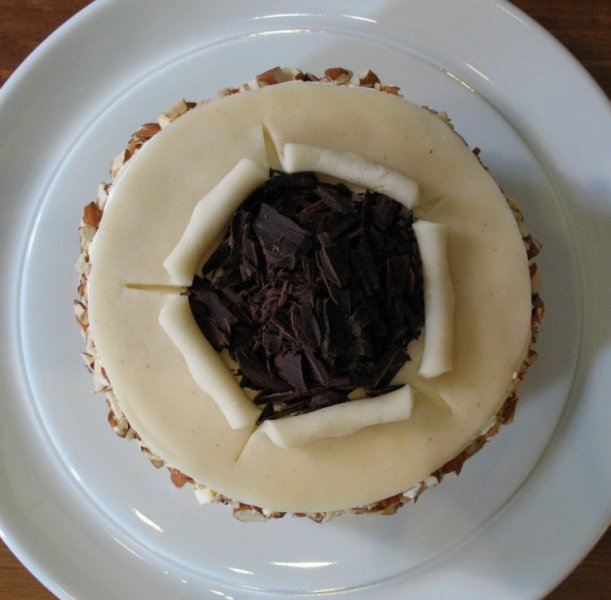
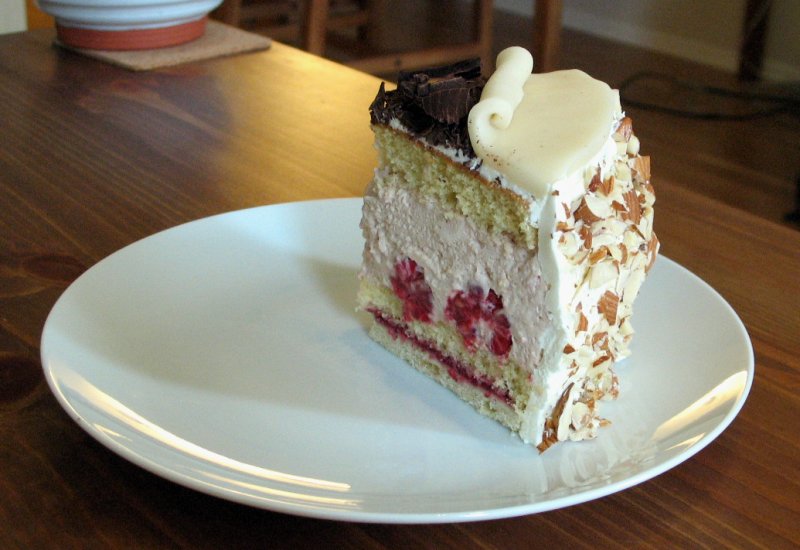
- hansjoakim's Blog
- Log in or register to post comments
Hans, your loaves and desserts are always such an inspiration to me! I am one of your greatest fans. Thanks so much for the wonderful post and write up.
--Pamela
That cake looks fabulous. Dave
Hans, I can't make up my mind which I like the most..the bread or the cake! They are both gorgeous and tasty looking!
Sylvia
That cake is mouthwatering.
While the bread is lovely - the cake rocks.
Gotta run and get a chocolate fix now...
oh good gracious! That cake looks absolutely mouth watering!!
Have you a culinary background or are you just obnoxiously naturally talented? Just kidding. Your breads are beautiful, but you kill me with those desserts! I think you should do a dessert blog and I'll be your first subscriber!
Betty
Thanks for your comments and feedback, everyone :)
Pamela: *blush*... I don't know what to say, really... Thank you! *big hug*
I think baking bread is most rewarding and lots of fun. Making pastries are hard work (I'm telling you, that cake left me empty and exhausted), but when they turn out alright, there's no thing like it, if you ask me. It's interesting how baking is this two-headed beast: There are the rustic, man-handled loaves on one side, and then there are the delicate, innocent and fragile pastries on the other. I think it's very rewarding to work with both, as I feel they compliment each other and fill different... I don't know... desires or "needs"?
wish i had your touch, hans!
WOW!!! All these years and I thought I was doing pretty well making Cinnamon rolls, Pita Bread, Hamburgerbuns etc....but you put me in the dirt!! MY LORD those are works of ART!!!! I have so much to learn!! When you were talking about the ratios and how wet the dough was, you went RIGHT over my head!! I will look forward to seeing more of your blogs from here on out!! At the risk of showing my true ignorance, just what is a Levain??
Jannrn
Thank you, ques2008 and Jannrn :)
Jannrn: Thanks! Don't let those ratios scare you - once you're familiar with baker's math, it's a very convenient tool to break down recipes and communicate the essentials of the dough. Many people around here will give you a better explanation than I can, but I'll try to convey the basics: Picture all the ingredients you put into your total dough (there's a pile of flour, a mug of water, some pinches of salt etc.). Now, measure everything by weight. The total weight of flour defines "100%". So, as a toy example, imagine you've got 100 gr. flour in your recipe, then 1 gr. = 1%. So, when I say in the post above, that the dough is composed of "20% whole grain flour" (i.e. the spelt loaf), that means that, in the toy example, that there is 20 gr. whole grain flour (i.e. whole spelt flour) and 80 gr. white spelt flour. All your other ingredients can also be related to those "100%" too. When I write that the dough is hydrated at 67 - 68%, for the toy example, that means that there is between 67 gr. and 68 gr. water.
In the Herbstzauber I used a "60/40 rye dough". By this, I mean that the total flour in the dough is a mixture of 60% rye flour and 40% white flour (all-purpose or bread flour). These ratios and percentages are very neat to use, because you can communicate what kind of dough you're using without explicitly pointing out the total weight of the dough. They're great if you want to scale a recipe - consider the toy example again. Say we want to double the dough. If we want to double it, 2 gr. = 1%. So we got 200 gr. flour. 20% whole grain flour = 40 gr. whole grain flour. 67% hydration = 134 gr. water and so forth.
By "levain", I mean a ripe sourdough. This is a mix of flour, water and a sourdough culture that has been fermenting and is mature enough to put into the final dough. There are so many different names for the same thing, that anyone coming to the field is bound to be confused at one stage or another...
Drop me a line if you think I can assist in any way! :)